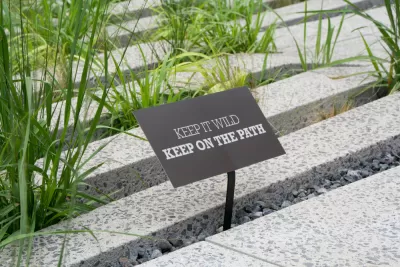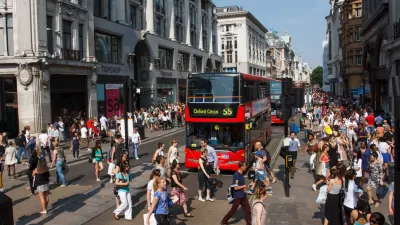Design criticism bridges the gap between the process and product of design, and the public’s understanding and appreciation for it. But does it have to be all about architecture?

Metropolis Magazine recently published a roundtable conversation featuring several notable writers, educators and critics addressing traditional, long-form architectural criticism and whether it can remain relevant and influential in today’s media market dominated by sound bites and inexhaustible online opinion sharing. The piece is loaded with hints of existential angst, but the basic message is—not surprisingly—that the voice of the qualified design critic is still as important as ever.
I certainly can buy this argument, as I am a big fan of well done design criticism. Good critical writing extends way beyond telling people what they should or should not like. It can (and should) be insightful, entertaining and informative, and has the ability to provide people with the knowledge and vocabulary to understand why they prefer certain buildings and places to others and, more importantly, why good design is essential to very real quality of life issues.
Design criticism was once a fixture at newspapers of all sizes. Today, however, it is primarily limited to big hitters like The New York Times, Los Angeles Times, and Chicago Tribune. While critics have access to broader readership these days, thanks to the Internet, they also have to compete for attention alongside countless other writers, bloggers, and Twitter feeds. Very few online voices have managed to rise above the prattle to achieve a similar level of respect, so the elite is a small group.
The Metropolis piece addresses these issues while inadvertently highlighting my personal frustration with contemporary design criticism’s relentless alignment with architecture. I appreciate that most of the top critics self-identify as architecture critics and should, of course, write about what interests them and their audience. What irritates me—and I realize I may be an outlier here—is that this is one more example of how the broad, multi-disciplinary practice of urban design has been hijacked by the media-fueled frenzy over all things architecture. Sure, buildings play a big role in shaping the form of cities, but it is good planning that creates the framework for good design, and the space between the buildings—the public realm—that truly creates community.
Important open space projects involving collaboration between planners and teams of landscape architects, engineers and architects are transforming cities in all regions of the country. Projects like the High Line, for instance, have helped to redefine the potential that exists in the cores of our older cities…and yet we still talk about the architects. That’s not all by accident.
Not too long ago I wrote a congratulatory piece recognizing the innovators behind the High Line. As it originally appeared, I referred to the project’s landscape architect as the designer, without mentioning the rest of the team by name. This made sense to me as the firm was listed as lead consultant. However, those at the architecture firm for the project didn’t agree, and made that clear in a polite, yet vaguely threatening call to me on behalf of one of their principals demanding they be given equal billing.
I was surprised that getting credit in a little blog really matters that much, but I also understand that being recognized as part of a famous project like that can mean big business. This new focus we are seeing on landscapes in cities has architects extra competitive in areas they used to not care much about. Savvy marketing staffs are doing their best to capitalize on excitement from social media and design web sites to help A-list architecture firms perfect the art of self-promotion and, in turn, control the narrative surrounding urbanism.
Thankfully, there is an increasing amount of quality journalism being dedicated to the role landscape plays in the redevelopment of cities – particularly in niche publications like the superb Landscape Architecture Magazine. But aside from reviews by architecture critics of high profile projects in big cities like New York, Los Angeles, and Philadelphia, intelligent landscape-focused criticism remains hard to come by.
The New Republic published perhaps the most substantive critical take on the urban landscape several years ago with the essay “Park Here,” written by the architecture critic Sarah Williams Goldhagen. In it she provides an in-depth review of The High Line, Millennium Park, and Citygarden, building the argument that contemporary urban parks play a vital role in the social life of cities. It is an important piece for people interested in urban design to read.
As clever and spot-on as some of her critiques are, however, Goldhagen still comes across as an architect talking about landscape, even going so far as to proclaim “The great urban park must be architectural.” Her point—which I agree with—is that urban parks need to be of a scale and character that can hold their own against the dense urban environments they inhabit, but her choice of phrase conveys a bias that carries throughout the piece.
All critics need their point of view and I do not mean to suggest otherwise. I would rather read a talented architecture critic weigh in on landscape than have nothing to read at all. I am always thrilled when I find Inga Saffron, John King, or Alexandra Lange expressing their insights on landscape issues, but they seem less invested than when discussing architecture.
While there are many design fundamentals that bridge the disciplines of architecture and landscape architecture, it is the differences between them that matter when it comes to both designing places and critiquing them. Issues inherent in the landscape, such as ecology and temporality—things that buildings do not have to deal with—demand specific expertise. A building is typically complete at day one, and can be effectively evaluated as such. With landscape, however, its transitional nature must be understood in order to accurately address the intent of its design. In other words, works of landscape architecture need to be critiqued by someone sensitive to, and passionate about, the unique qualities of landscape: a landscape architecture critic. The problem, however, is I am not sure there is even such a thing.
It is probably not fear that discourages quality landscape criticism, as my title suggests. It is more likely a lack of interest—from both writers and editors. With the shrinking number of platforms available for all long-form design criticism, I’m not optimistic about this changing, and that is a shame.
We need design criticism, whether many people realize that or not. It is, in my mind, the most important way to bridge the gap between the process and product of design, and the public’s understanding and appreciation for it. And as urban open space moves to the forefront, it is something the landscape absolutely deserves.

Trump Administration Could Effectively End Housing Voucher Program
Federal officials are eyeing major cuts to the Section 8 program that helps millions of low-income households pay rent.

Planetizen Federal Action Tracker
A weekly monitor of how Trump’s orders and actions are impacting planners and planning in America.

Ken Jennings Launches Transit Web Series
The Jeopardy champ wants you to ride public transit.

California Invests Additional $5M in Electric School Buses
The state wants to electrify all of its school bus fleets by 2035.

Austin Launches $2M Homelessness Prevention Fund
A new grant program from the city’s Homeless Strategy Office will fund rental assistance and supportive services.

Alabama School Forestry Initiative Brings Trees to Schoolyards
Trees can improve physical and mental health for students and commnity members.
Urban Design for Planners 1: Software Tools
This six-course series explores essential urban design concepts using open source software and equips planners with the tools they need to participate fully in the urban design process.
Planning for Universal Design
Learn the tools for implementing Universal Design in planning regulations.
Ada County Highway District
Clanton & Associates, Inc.
Jessamine County Fiscal Court
Institute for Housing and Urban Development Studies (IHS)
City of Grandview
Harvard GSD Executive Education
Toledo-Lucas County Plan Commissions
Salt Lake City
NYU Wagner Graduate School of Public Service






























